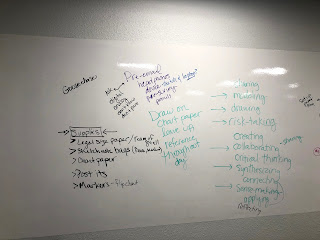On my journey to differentiated instruction, I know one non-negotiable of DI is strategic flexible grouping. During the past few years, I have worked diligently on grouping my students, but I know I need to improve the strategic part of my grouping process.
| (By the way, I use the "Touch Blur" app to blur students' faces.) |
I also learned that differentiation doesn't always mean group work, nor does it mean that groups are based solely on ability levels. Some lessons require "whole group" instruction, and then we can move into individual, partner, or small group work as necessary.
Types of Groups:
|
And groups may be based on...
|
Whole Class
|
Readiness
|
Small Groups
|
Interest
|
Pairs
|
Similar Learning Profiles
|
Individual Work
|
Random Selection
|
Choice
|
In addition, I learned you must establish a community in your classroom to make the different groups most effective. Students must be willing to talk with each other, take risks together, and know how to truly collaborate on their work. To help with the community building in class, as soon as I change my groups, I ask students to introduce themselves and answer a question that requires collaboration. (Rate yourself from 1-10 on how you're feeling today, and average all of your ratings. Come to a consensus about the best thing to eat in the cafeteria.) I love Sarah's idea for establishing group norms, and you can download her posters from her blog. And finally, let's not forgot about the classroom management aspect of the group process. When working on building community and flexible grouping, it's so important to have those procedures in place about moving desks, turning in work, getting materials, ...
To help students understand that grouping is a norm in our class, at the beginning of last year (and I will repeat) we did a quick "line up" activity. I had huge classes, so the students actually remained seated, but I participated, too. I projected the list shown here, and we went through the items one by one. It is more effective when you can demonstrate a line up and have your kids move from one end of the spectrum to the other, but they got the point by their self-assessments. After we went through the entire list, I asked questions such as who had a chance to rate themselves as a 4 or 5? And who rated themselves a 1 or 2 at least once? The final reflection: in our class this year, there will be times when you will be an expert and times when you will be a novice. You may sometimes be grouped with like team members, but sometimes, I will want you to "stretch," and you may be grouped outside of your comfort zone. (Here's an opportunity to share a bit about making mistakes, grit, and growth mindset!)
The line-up activity is great for establishing the understanding of groups based on readiness, but since I'm on a quest this year to group by learning profile, I think (hope!) it will work for the idea of any changing groups.
Unfortunately, I only strategically grouped a few times last year, but it was a great victory for me when a student walked in and asked, "Do you want us to sit in our CAP groups or our random groups?" So at least I'm getting the grouping thing down a bit better. Another bit of great feedback--an end of year note included the comment, "I learned to collaborate with my peers, some of whom I had never talked to before."
So now I have the grouping component ready to try again, and I really want to focus on differentiating by learning profile...next steps: put the two together and work on specific lesson components!
Any suggestions for creating a community of learners in your classroom? How do you create groups?

